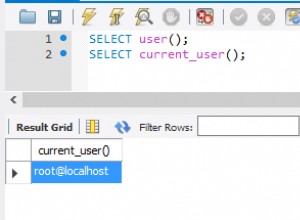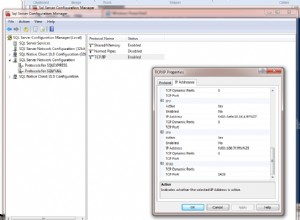Você pode usar o unpivot/pivot para obter o resultado desejado. Existem algumas maneiras diferentes de obter o resultado, se você tiver um número limitado de valores, poderá codificar a consulta, mas se tiver um número desconhecido de valores, precisará usar o SQL dinâmico.
O processo UNPIVOT converterá as várias colunas de
c1 , etc` em várias linhas. Quando os dados estiverem nas várias linhas, você poderá aplicar facilmente a função PIVOT. Você pode usar a função unpivot ou CROSS APPLY para converter os dados de várias colunas:select id,
col = 'Service'+Service+'_'+col+'_'+cast(seq as varchar(10)),
value
from
(
select id, service, c1, cn
, row_number() over(partition by id
order by service) seq
from yourtable
) t
cross apply
(
select 'c1', c1 union all
select 'cn', cn
) c (col, value)
Consulte SQL Fiddle with Demo . A aplicação cruzada converterá seus dados no formato:
| ID | COL | VALUE |
| 1 | ServiceA_c1_1 | 5 |
| 1 | ServiceA_cn_1 | 3 |
| 1 | ServiceB_c1_2 | 2 |
| 1 | ServiceB_cn_2 | 1 |
| 2 | ServiceA_c1_1 | 9 |
| 2 | ServiceA_cn_1 | 4 |
Uma vez que os dados estejam neste formato, você pode aplicar PIVOT:
select id, ServiceA_c1_1, ServiceA_cn_1,
ServiceB_c1_2, ServiceB_cn_2
from
(
select id,
col = 'Service'+Service+'_'+col+'_'+cast(seq as varchar(10)),
value
from
(
select id, service, c1, cn
, row_number() over(partition by id
order by service) seq
from yourtable
) t
cross apply
(
select 'c1', c1 union all
select 'cn', cn
) c (col, value)
) d
pivot
(
max(value)
for col in (ServiceA_c1_1, ServiceA_cn_1,
ServiceB_c1_2, ServiceB_cn_2)
) piv;
Consulte SQL Fiddle with Demo .
Então, se você tiver um número desconhecido de valores, poderá converter a consulta acima em SQL dinâmico:
DECLARE @cols AS NVARCHAR(MAX),
@query AS NVARCHAR(MAX)
select @cols = STUFF((SELECT ',' + QUOTENAME('Service'+Service+'_'+col+'_'+cast(seq as varchar(10)))
from
(
select service,
row_number() over(partition by id
order by service) seq
from yourtable
)d
cross apply
(
select 'c1', 1 union all
select 'cn', 2
) c (col, so)
group by seq, Service, col, so
order by seq, so
FOR XML PATH(''), TYPE
).value('.', 'NVARCHAR(MAX)')
,1,1,'')
set @query = 'SELECT id, ' + @cols + '
from
(
select id,
col = ''Service''+Service+''_''+col+''_''+cast(seq as varchar(10)),
value
from
(
select id, service, c1, cn
, row_number() over(partition by id
order by service) seq
from yourtable
) t
cross apply
(
select ''c1'', c1 union all
select ''cn'', cn
) c (col, value)
) x
pivot
(
max(value)
for col in (' + @cols + ')
) p '
execute sp_executesql @query;
Consulte SQL Fiddle with Demo . Ambos darão um resultado:
| ID | SERVICEA_C1_1 | SERVICEA_CN_1 | SERVICEB_C1_2 | SERVICEB_CN_2 |
| 1 | 5 | 3 | 2 | 1 |
| 2 | 9 | 4 | (null) | (null) |




